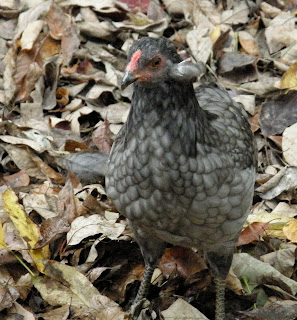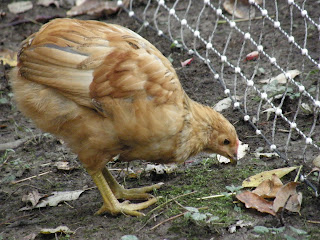The mobile coop in front
It’s been a busy few months since the last post. I left Bug and Cricket with Clucky and let nature take its course with them. They did seem to recover by the time they were about a month old, but then at the beginning of November I came home from work to find no trace of Bug. I hunted within the enclosure for any sign and came up empty. My guess is that the Cooper’s hawk that I had started seeing around swooped in and carried him off--Bug was still small enough. Hawks migrate in the fall, so this bird might have been a stranger--for whatever reason (roosting vultures, resident crows, the strings and flags around the coop, adequate cover for the chickens), I have had no problems at all with whatever raptors are around during the breeding season. All the leaves had fallen by that point, so there was less cover for the chickens and they were starting to look nervously up at the sky.
With that in mind, the following weekend I took down the second length of electronetting to keep the chickens closer to the coop and in preparation for for the frozen ground and snow which have yet to materialize. The halving of their space made it more imperative to trim down the flock. I set up the mobile coop out in the front field and moved all the blue and black Araucanas--Kiwi, Raven, Dove, Hawk, and Magpie. I decided to sell Kestrel, Raven, Dove, and Bunting and put them all on Craig’s List.
Bunting and Kestrel
Show beauty
At the Ohio National Poultry Show this fall I finally succeeded in my quest to see a show-quality Araucana. This beautiful black pullet was the only one of her breed. I stared and took pictures and she gazed regally at me. Comparing her to my flock, it is apparent that a lot of my birds are too leggy and gamy looking. It seems that Oriole and Hawk have the best body type of the first set.
Tall, skinny Kiwi
Oriole
I have been diligently working on better understanding poultry color genetics in my spare time. I’m making progress I think. Oriole remains the biggest mystery, but when someone on the Backyard Chickens Araucana thread pointed out to me that he has spangles on his breast, I realized that he is almost certainly birchen (ER) based. This fits with his down color and early patterning as well. Crossing him with Lark who has recessive wild type coloration would reveal what else he may hide. I think Wren may also be birchen based--she seems nearly brown red with some melanization and perhaps spangles as well, and she had a “helmeted” down pattern too. So I really have three color groups: blue/black/splash, birchen, and wild type. I find myself dreaming of additional coops.....
Wren
Dove's little surprise
A week ago, a neighbor bought Raven, Dove, and Bunting to start a flock of blue egg layers. Before they were picked up, I took some final pictures and discovered that Dove had a secret--a tiny single tuft. I had been thinking she ought to go well with Kestrel--they both have some blue and her tail would balance out his short back. Tufts would complete the package, but my neighbor preferred Raven and so off they went.
Raven
A few days later, I came home from work after dark in the rain to find Hawk missing. I hunted around her enclosure and up in the evergreens nearby, but I found no sign. I gave up and went to close up the back coop and there she was on the roost with the others! I think she was spooked out of her run in front (although severely clipped on one wing, all the Araucanas in front can fly), spent the day in the yard, and when dusk fell went back to her original home to roost. I left her there, and the next day she wandered around with no one to hang out with, already a stranger. I put her back with Kiwi and Magpie the next night where she has remained.
Hawk
The main coop is strife-filled these days with all the different age groups and with Oriole and Kestrel chasing the girls, especially the little Araucana pullets who aren’t quite mature enough to find the boys attractive. Finn, who I thought might be imposing enough to keep this behavior to a minimum has turned a blind eye, even when "his" older hens get ambushed. Even though he and I have a tenuous relationship, I am appreciating even more how nice he is to his hens and how much they like him back.
Meanwhile, it has become apparent that Cicada and Cricket who remained with Clucky until yesterday at 12 weeks of age are both male. I plan to keep Cicada, despite his being clean-faced and only partially rumpless because his body type is much more correct than some of the older Araucanas. He also has been healthy and vigorous from the beginning and will be the only one I keep from this bloodline.
Cicada and Cricket
Cricket, although he seems healthy now, ended up being extremely runty. After it became apparent that he was a boy, I have worried about his fate. There is someone coming today who is interested in him for a pet, and might take Kestrel as well. I hope it works out!














































